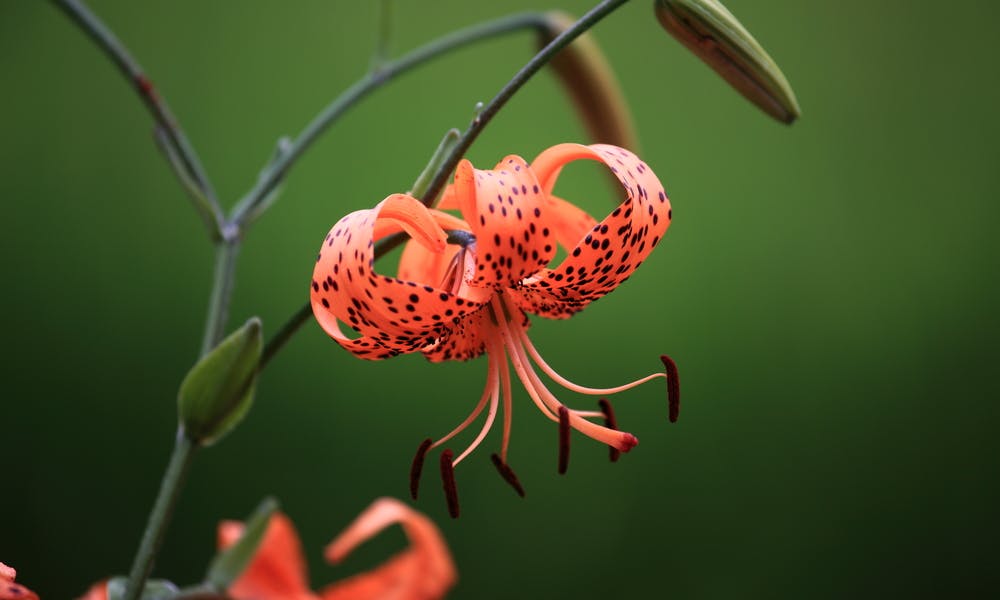If you’re looking to truly brighten up your garden this year with a flower that can draw attention like no other, the tiger lily flower is for you. This prolific flower, part of the Lily family, has flower petals that are a deep orange with a multitude of dark black or crimson spots all over, giving it a resemblance to, you guessed it, a tiger. It is a delightfully decorative plant that is showcased in many a garden around the world. It has a hardy nature, as well as edible bulbs that have been used for countless years throughout Asia. All this makes it a great, and easy to grow, addition to any home.
In this article we are going to discover all there is to know about the tiger lily.
Keep on reading to find out:
- The History of the Tiger Lily
- Flower Facts
- What Does It Symbolize?
- Use in Cuisine and Medicine
- How to Grow Your Own Tiger Lily
The History of the Tiger Lily
For years the tiger lily was known by its scientific name, L. tigrinum until the older Lilium Lancifolium was determined to be its proper name. Part of the Lily family, the tiger lily, not to be confused with the many other flowers, which bear the same name by mistake, is native to parts of Asia such as China, Japan, Tibet, Korea, as well as eastern Russia. It has been cultivated throughout North America, with many plants making incursions into the wild as well. Cultivars have managed to create new colors besides the original orange and black, with white, yellow, red, and pink being available. It is a commonly found near water.
Flower Facts
A perennial flower growing alongside ditches and waterways, the Tiger Lily hold themselves on upright stems that are 80–200 cm (31–79 in) tall and grow large leaves 6–10 centimeters (2.4–3.9 in) long and 1–2 centimeters (0.39–0.79 in) broad. The flower produces aerial bulblets, generally known as bulbils, in the axils of their leaves. The bulbs usually grow up to 122 cm in height and around 30 cm wide. The native species flowing leaves, which tend to wrap around itself, are lent their look by the gracefully curving tepals upon their blossoms, while their spotted colors give it its tiger-like resemblance. Unlike many other flowers, the tiger lily has no fragrance. They bloom and fade away within days, leaving behind the thin seed-like bulbils if pollinated. It is a hermaphrodite species and is usually pollinated by bees.
What Does it Symbolize?
The tiger lily is generally gifted to others as a symbol of friendship. It is, however, also used as a symbol of wealth, pride, and prosperity. Its deep orange color symbolizes passion and love. There are several ancient stories of the tiger lily throughout Asian culture. One of these old myths tells the story of a hermit who found a tiger with an arrow jabbed into his body. The hermit attempted to remove the arrow and save the tiger, but the tiger died. However, the tiger told the grieving hermit that their friendship would survive after its death. The tiger’s body then transformed into the tiger lily flower, becoming an everlasting symbol of their friendship.
Use in Cuisine and Medicine
The bulb is sometimes used as a vegetable, like a parsnip. It must be boiled as it can be quite toxic. its bitterish taste is a lovely companion to stews and other thick dishes. It was grown as a root crop for many years on farms in Asia. The bulb is anti-inflammatory and used as a diuretic in some instances. They are used in Korea to treat coughs, sore throats, and heart palpitations. A tincture is commonly made from the flower, harvested only in full bloom, and is used to treat congestion and sometimes to help with nausea. Some believe the flower can be used to treat heart disease. In ancient Asia, it was thought to help deal with issues of aggressivity. Somewhat ironically, the tiger lily is very toxic to cats, leading to symptoms of lethargy, vomiting, possible kidney failure, and even death. There is no known toxicity to other species.
How to Grow Your Own Tiger Lily
Comparatively to other plants, the tiger lily is relatively easy to grow. The lilies do very well in moist soil and can be found growing near ditches and small, shallow waterholes. Early to mid-autumn is the best time to plant the bulbs in temperate areas, while in more warmer areas they can be planted out as late as late autumn. Due to most tiger lilies being sterile, they must be regrown through the bulbils (small bulbs) that are found along the leaf’s axil. The scales along the bulb must be taken from the bulbils and grown in moist peat in a dark, cool area until they grow bulblets. They can then be grown in a nursery and later planted outside. Well-drained soil is a must. Being highly disease resistant, not much care is needed. Fertilize in poor soil only. They grow in full sun or partial shade.
The Fierce Tiger Lily
This stunning flower can be a wonderful partner to any outdoor garden or a great way to spruce up the inside of any home or office. The flowers are particularly suited to containers and can last for up to two weeks in a vase if properly cared for. Watch out if you’re a cat lover, but otherwise, this can be the perfect way to brighten up a dreary landscape. With its vivid orange color offset by its dark spots, the fierce looking tiger lily might just be what you have been waiting for.
